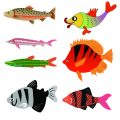Understanding Different Types of Fishing Reels
If you’re new to fishing, choosing the right reel can feel overwhelming with so many options available in the U.S. market. The first step is understanding the main types of fishing reels and how each one fits different angling styles. Spinning reels are incredibly popular among beginners because they’re easy to use and versatile for various freshwater and light saltwater situations. Their open-faced design makes casting smooth, even for those just starting out. On the other hand, baitcasting reels offer more precision and control but come with a steeper learning curve. These are often favored by experienced anglers targeting larger fish or using heavier lures, but they can be frustrating for newcomers due to the risk of line tangles or “backlash.” For true simplicity, spincast reels—often called “push-button” reels—are a classic choice for American beginners, especially kids. With a closed-face design and straightforward operation, spincast reels minimize complications and let you focus on enjoying your time by the water. When starting out, most U.S. anglers find spinning or spincast reels to be the most user-friendly options while learning the basics of casting and reeling in their catch.
2. Factors to Consider Before Buying
Before you purchase your first fishing reel, it’s important to weigh several key factors that will help you make the best choice for your needs and local conditions. Here’s a breakdown of what you should keep in mind as a beginner angler in the US:
Fishing Location
Your fishing destination plays a major role in choosing the right reel. Are you planning to fish in freshwater lakes, rivers, or ponds, or do you see yourself casting lines off saltwater piers or beaches? Freshwater reels are generally lighter and less corrosion-resistant than saltwater reels, which are built to withstand harsh marine environments.
Target Species
The type of fish you aim to catch affects the size and strength of the reel you’ll need. For example, targeting bass or trout requires a different setup than going after larger saltwater species like redfish or striped bass. Matching your reel to the average size and fight of your target fish ensures an enjoyable and successful experience.
Reel Materials
Reels are typically made from graphite, aluminum, or a blend of both. Graphite reels are lightweight and budget-friendly—great for beginners—while aluminum reels offer more strength and durability, making them suitable for fighting bigger fish or enduring rougher use. The table below highlights the pros and cons of each material:
| Material | Pros | Cons |
|---|---|---|
| Graphite | Lightweight, affordable, corrosion-resistant | Less durable under heavy loads |
| Aluminum | Strong, durable, smooth operation | Heavier, more expensive |
Gear Ratios
The gear ratio tells you how many times the spool turns with each crank of the handle. A higher ratio (like 6:1) retrieves line quickly—ideal for fast-moving lures or covering lots of water—while a lower ratio (like 4:1) provides more torque for hauling in big or stubborn fish. Beginners usually benefit from a medium gear ratio (around 5:1), offering versatility for various techniques.
Budget Considerations
Your budget is always an essential factor. Entry-level reels in the US can range from $30 to $100. While it might be tempting to go for the cheapest option, investing a little more often results in better durability and smoother performance. Look for reputable brands that offer solid warranties and positive user reviews.
Taking these factors into account will help narrow down your choices and set you up for a rewarding start to your fishing journey.
![]()
3. Popular Reel Features and U.S. Market Trends
When choosing your first fishing reel, it’s important to understand which features are popular among American anglers and why these trends matter for beginners. The U.S. market emphasizes innovation and user-friendly technology, making certain reel features especially desirable for new fishermen and women.
Drag System: Smoothness Matters
The drag system is one of the most talked-about aspects in the U.S. reel market. Beginners should look for reels with a smooth, adjustable drag that allows you to control how much resistance a fish feels when pulling on the line. Top brands offer carbon fiber or multi-disc drag systems, which provide consistent pressure and help prevent line breakage—crucial when learning how to fight fish without losing your catch.
Anti-Reverse Function: Preventing Backplay
Another trending feature is the anti-reverse mechanism. This function stops the handle from spinning backward, ensuring solid hooksets and minimizing slack in your line. For beginners, this means fewer missed catches and more confidence as you develop your technique. Most modern reels sold in the U.S., especially spinning and baitcasting models, come equipped with instant anti-reverse switches for added convenience.
Material and Build Quality
American buyers also pay close attention to materials like aluminum and graphite. These lightweight yet durable options provide comfort during long fishing sessions and reduce fatigue for new anglers who may not be used to holding a rod all day. Corrosion-resistant finishes are also popular, particularly for those fishing in saltwater environments like Florida or California coasts.
Gear Ratio and Line Capacity
The trend toward higher gear ratios means faster retrieves—a handy feature when targeting fast-moving fish or covering lots of water quickly. New anglers often benefit from medium gear ratios (around 5:1 to 6:1) because they offer a balanced blend of speed and power. Line capacity is another focus; U.S. reels usually indicate how much monofilament or braided line they can hold, helping beginners match their reel to local species and waters.
By focusing on these trending features—smooth drag systems, reliable anti-reverse mechanisms, high-quality materials, optimal gear ratios, and generous line capacities—you’ll be better equipped to select a reel that fits both your skill level and the unique demands of American fishing spots.
4. Best Fishing Reel Brands for Beginners in the US
When you’re new to fishing, choosing a reel from a reputable brand can make all the difference in your experience. American anglers often favor certain brands not just for their quality and innovation, but also for their commitment to providing beginner-friendly options. Here’s a look at some of the most trusted brands that consistently deliver reels perfect for novices.
Top-Rated Beginner-Friendly Fishing Reel Brands
| Brand | Notable Beginner Models | Main Advantages |
|---|---|---|
| Penn | Penn Battle III Spinning Reel, Penn Fierce III | Durability, easy-to-use drag systems, widely available parts |
| Shakespeare | Shakespeare Ugly Stik GX2 Combo, Shakespeare Alpha Spinning Reel | Affordable combos, forgiving gear systems, popular at major retailers |
| Abu Garcia | Abu Garcia Black Max Baitcaster, Abu Garcia Revo X Spinning Reel | Smooth operation, lightweight design, ideal for learning baitcasting basics |
| Daiwa | Daiwa Revros LT Spinning Reel, Daiwa Crossfire LT | User-friendly features, value pricing, reliable for both freshwater and light saltwater use |
| Zebco | Zebco 33 Spincast Reel, Zebco Omega Pro | Simplified push-button casting, tangle-resistant designs, perfect for kids and absolute beginners |
Why Brand Matters When Starting Out
Choosing an established brand means you’ll have better customer support, easier access to replacement parts, and plenty of online resources like how-to videos tailored to your specific reel model. These top brands are also frequently stocked at big-name US retailers such as Bass Pro Shops, Cabela’s, Walmart, and Dick’s Sporting Goods—making it easier to try before you buy or get help if you run into issues.
Pro Tip: Start with Combo Sets
If you’re truly new to fishing, consider purchasing a rod-and-reel combo from one of these brands. Combos are matched by experts for balance and ease-of-use right out of the box—eliminating the guesswork and letting you hit your favorite local waters faster.
5. Where to Buy: Online vs. Local Stores
When it comes to buying your first fishing reel, deciding where to shop is just as important as choosing the right model. American anglers have a variety of options, from big online retailers like Bass Pro Shops, Cabela’s, and Amazon to the tried-and-true local tackle shop down the street. Each option offers unique advantages for beginners.
Shopping Online: Convenience and Selection
Online retailers such as Bass Pro Shops, Cabela’s, and Amazon are popular choices for their wide selection and competitive pricing. You can browse hundreds of reels, compare brands, read user reviews, and often find deals or free shipping—perfect if you’re looking for convenience or live far from a brick-and-mortar store. These sites also provide helpful buyer guides, detailed specifications, and sometimes video demonstrations to help you make an informed decision without leaving home.
Visiting Local Tackle Shops: Personalized Service
Your neighborhood tackle shop offers something online stores can’t match: face-to-face service from knowledgeable staff who know the local waters and what works best in your area. They can answer your questions on the spot, show you how reels feel in your hand, and even recommend specific setups based on your target species or favorite fishing spots. Many shops also host community events or classes that are great for building your skills and meeting fellow anglers.
Weighing Your Options
If you value convenience, variety, and competitive prices, shopping online may be your best bet. But if you appreciate hands-on advice and want to support small businesses in your community, check out your local tackle shop before making a purchase. Some beginners find success by researching online first and then visiting a store to get personalized recommendations or to physically test out different reels.
Pro Tip
No matter where you buy, always check return policies and warranty information—especially as a beginner. This ensures you’ll be satisfied with your new reel or can easily exchange it if it doesn’t meet your expectations.
Tips for Maintaining Your First Fishing Reel
Taking care of your fishing reel is essential to keeping it performing smoothly and lasting through many fishing seasons. Here are some simple maintenance tips and product recommendations specifically tailored for beginner anglers in the US.
Regular Cleaning Matters
After each fishing trip, especially if you’ve been in saltwater or muddy conditions, rinse your reel gently with fresh water. Avoid using high-pressure sprays as they can force debris into the reel’s internal mechanisms. A soft cloth or towel works best for wiping down the exterior. For deeper cleaning, consider a mild soap designed for sports equipment.
Lubrication Is Key
Every few outings, apply a small amount of reel oil to the moving parts—like the handle, bail arm, and line roller. This helps prevent rust and keeps everything running smoothly. Well-known products like Penn Reel Oil or Abu Garcia Reel Lube are affordable and easy to find at most US sporting goods stores.
Proper Storage Practices
Always store your reel indoors in a cool, dry place. Loosen the drag when not in use to relieve tension on the internal components. If possible, keep your reel in a padded case or soft bag to avoid accidental knocks or dust accumulation.
End-of-Season Checkups
At the end of each season, take a little extra time to inspect your reel for signs of wear such as frayed lines, loose screws, or sticky mechanisms. Most major brands like Shimano and Daiwa offer beginner-friendly maintenance kits that include everything you need for basic upkeep.
When to Seek Professional Help
If you notice grinding noises, corrosion, or significant performance issues that home maintenance can’t fix, don’t hesitate to bring your reel to a local tackle shop or authorized service center. They can provide expert cleaning and repairs to keep your gear reliable year after year.
With just a few minutes of care after every trip—and some handy American-made maintenance products—you’ll get the most out of your first fishing reel and enjoy stress-free angling adventures season after season.


